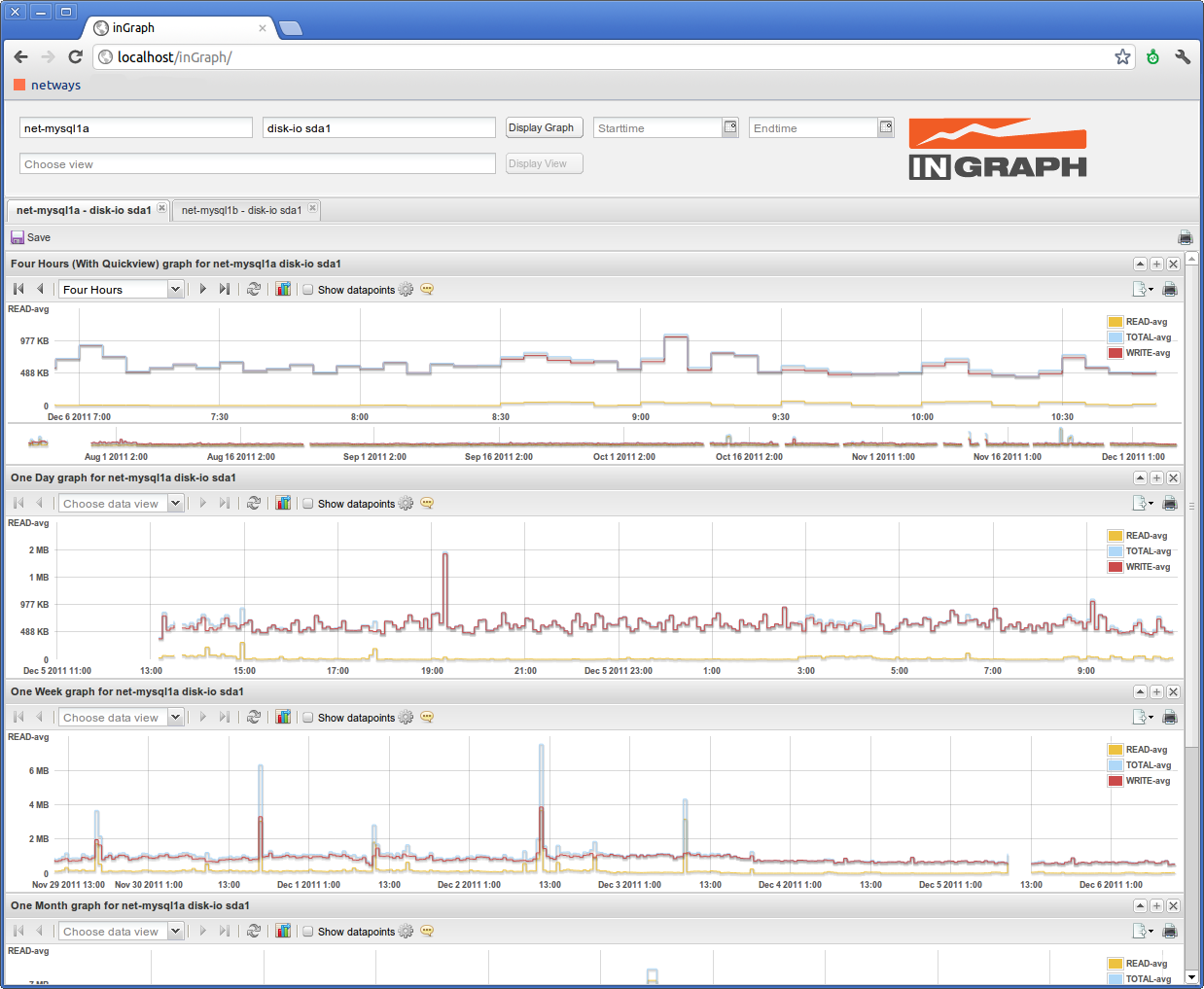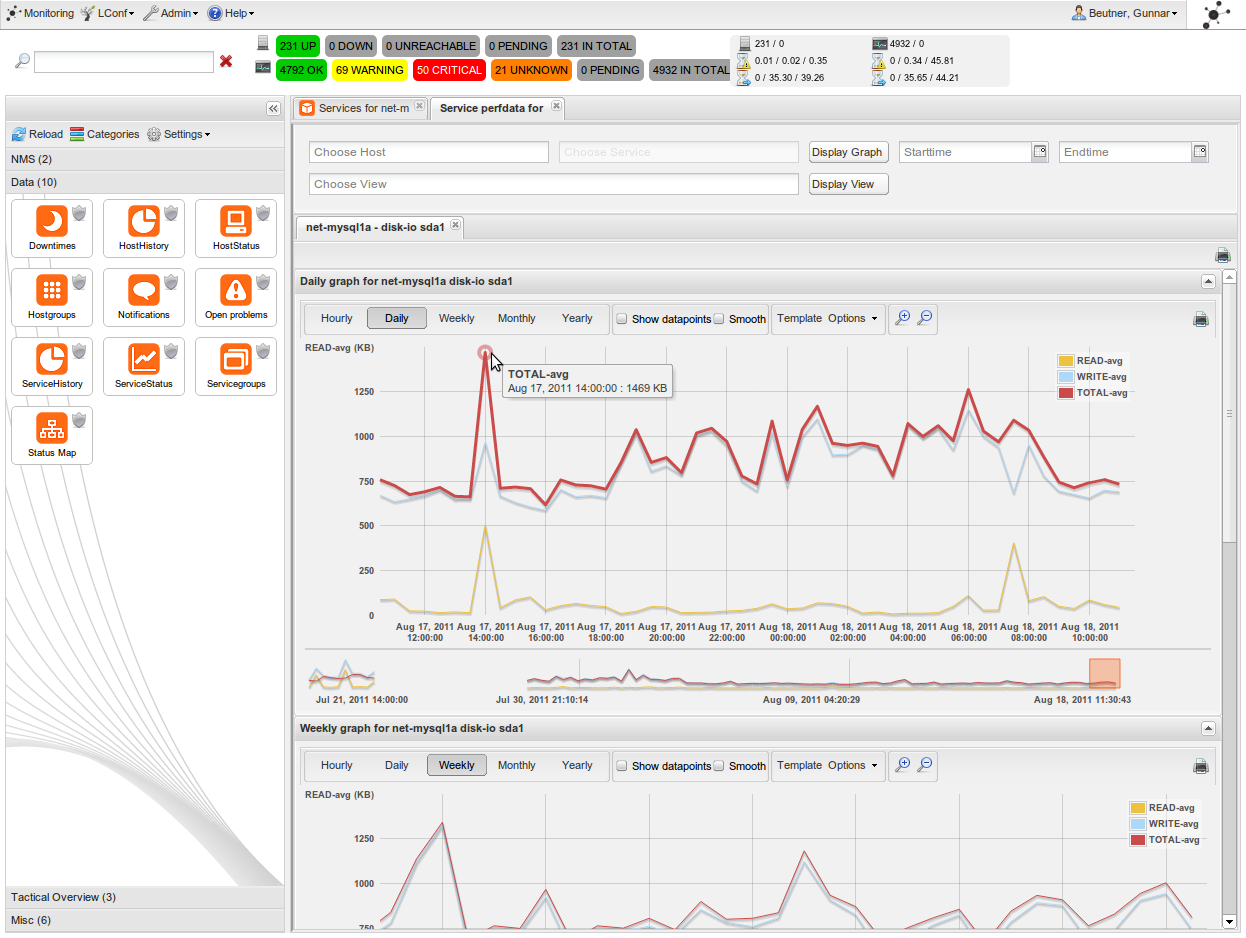 5 – 9 December packed the first advent with the release of InGraph and a Gude plugin, tips on email address verification and automatic IPv6 configuration.
5 – 9 December packed the first advent with the release of InGraph and a Gude plugin, tips on email address verification and automatic IPv6 configuration.
Following the excitement from the preview made at the OSMC, Gunnar released inGraph for download. Aside from generating informative graphs of Nagios/Icinga performance data, inGraph also features a cronk for seamless integration into Icinga Web. This includes a preview graph accessible from the service view, which displays information in line with user rights and permissions. In the standalone version too, graphs can be customized with the help of templates, and graphs from various hosts and services can be combined for comparison. InGraph comes with a check plugin to also offer trending of certain services. For more information see the inGraph project wiki.
On the topic of releases, Birger shared a new check plugin for Gude sensors to go with the new temperature, humidity and current/voltage sensors in store. These include the expert net control 2101/2151 and expert net control 2i2o 2100/2150, with the expert sensor box 7212 and Gude conductors with measurement still to come. The check_gude.pl for Nagios/Icinga can be found in our plugins area.
Per Georg, the same new devices from Gude featured in the hardware exhibition at the OSMC, alongside the Multitech iSMS, Nagios USB traffic light and Starface VoIP appliance for voice alerts.
From Managed Services, Sebastian explained Domain Keys Identified mail for the verification of sender email addresses, contrasting it to the Sender Policy Framework (SPF). The latter creates a record in the DNS zone file with the allowed MTA mail server IP addresses for the receiving server to verify the domain against. Domain Keys Identified mail however, uses a private key generated signature in each email’s header, which can be verified against a corresponding key located in the DNS zone.
Carsten then offered his tip for automatic IPv6 configuration with the help of radvd. Making the most of the IPv6 stateless address auto configuration feature, he gave an example of an radvd configuration on site local addresses. He noted however, that stateless address auto configuration is currently only possible on a DHCPv6 server.
To end the week with some festive cheer, Bernd declared the world’s best shashlik to be found at the Nuremberg Christmas market.
NETWAYS Blog
großer Ansturm auf die Monitoring-Hardware-Ausstellung auf der OSMC
Auch dieses Jahr war unserer Shop mit einer Demo-Monitoring Umgebung auf der OSMC vertreten – die Besucher der OSMC konnten sich direkt von den neuesten Trends der Monitoring-Szene überzeugen. In unserer Demo Umgebung waren folgende Artikel ausgestellt:
- GUDE expert Power Control (Stromleiste für das Messen des aktuellen Verbrauchs – Schalten via Web ebenso möglich)
- GUDE expert net control 2101/2151
- GUDE expert net control 2i2o 2100/2150
- GUDE expert sensor box 7212 (noch nicht verfügbar)
Die ausgestellte Hardware wurde permanent in unserem Icinga überwacht. Kunden die sich von der Alarmierung überzeugen wollten erwärmten einen Sensor – kurze Zeit daruf wurde unsere Nagios-Ampel rot und zeitgleich gingen SMS und Voice-Alarmierungen ein.
Besonderer Beliebtheit erfreute sich außerdem der neue inGraph, der bereits auf unserem Demo-System zu sehen war. Wer Interesse an unserer Überwachungs-Hardware hat, sollte sich bei uns im Shop mal umsehen.
inGraph
Auf der OSMC wurde inGraph von Bernd Erk bereits kurz vorgestellt und nun ist es endlich soweit: Die erste öffentliche Version des neuen Graphing-Tools steht zum Download bereit.
Neben den obligatorischen Features, Performance-Daten von Nagios/Icinga zu erfassen und dazu aussagekräftige Graphen anzeigen zu können, bietet inGraph eine nahtlose Integration in Icinga-Web.
So kann z.B. aus der Service-Übersicht heraus über ein Vorschaufenster direkt auf Graphen zugegriffen werden. Der Zugriff auf die einzelnen Graphen wird dabei über das Rechtesystem von Icinga-Web gesteuert.
Doch auch wer kein Icinga-Web einsetzt, kann von inGraph profitieren. Zusätzlich zum Icinga-Web-Cronk gibt es eine Standalone-Version, die nahezu die gleichen Features aufweist.

In beiden Versionen lassen sich Graphen über Templates an die eigenen Anforderungen anpassen. Über Views können Graphen von unterschiedlichen Hosts und Services kombiniert werden, um so z.B. die Auslastung mehrerer Systeme auf einem Blick vergleichen zu können.
Die von inGraph gesammelten Daten können mit Hilfe des mitgelieferten Check-Plugins ausgewertet werden, um so z.B. Trends bei bestimmten Services überwachen zu können.
Mehr Informationen zu inGraph gibt es (auf Englisch) unter https://www.netways.org/projects/ingraph/wiki. Die jeweils aktuelle Version kann unter https://www.netways.org/projects/ingraph/files gefunden werden.
Weekly Snap: InGraph, Drobo + TimeCapsule backup & Certificates
 15 – 19 August gave us a peek into the new graphing addon inGraph and one of our managed services projects while explaining certificates and backup with a Drobo – TimeCapsule combo.
15 – 19 August gave us a peek into the new graphing addon inGraph and one of our managed services projects while explaining certificates and backup with a Drobo – TimeCapsule combo.
From the Managed Services team, Sebastian shared a little on a hosting project at search engine marketing agency crealytics. Alongside Xen Hypervisor, PostgreSQL hot standby streaming replication with load balancing, automatic failover and online recovery, the set up also boasted a MongoDB replica set and load balanced, high availability Tomcat-Apache application server with Ruby support. All safeguarded by internal and external Icinga monitoring and an external backup server, ensuring crealytics could focus on their business free from IT worries.
Lennart then took us on a safari through the certificate jungle, clarifying the differences between PEM, DER, PKCS#7 / P7B, PKCS#12 / PFX and their conversion with the help of OpenSSL. In the meantime, Birger combined his network attached storage (NAS), Drobo with TimeCapsule for accelerated backups that also work on Apple’s new Lion operating system.
Most exciting of all, Gunnar announced inGraph, our new graphing addon for the display of monitoring metrics in Icinga and Nagios systems. Designed with scalability in mind, the tool is intended to replace NagiosGrapher and NETWAYS Grapher V2. Thanks to a python based backend, inGraph can access data collected by external applications with the help of a XML-RPC interface. Via templates, monitoring data can be displayed in various combinations as seen in a preview of inGraph integrated into Icinga’s new web interface. The development team is currently ironing out features and documentation, in preparation of the release planned for the upcoming monitoring conference.
Neues Graphing-Addon: inGraph
Um Benutzern von Icinga und Nagios eine einfache Möglichkeit zu bieten, ihre Monitoring-Daten graphisch auszuwerten, haben wir ein neues Addon namens inGraph entwickelt, das zukünftig NagiosGrapher und NETWAYS Grapher V2 ersetzen soll.
Bei der Entwicklung des neuen Tools wurde Wert auf Skalierbarkeit gelegt, um auch den Einsatz in größeren Monitoring-Umgebungen zu ermöglichen. Das in Python entwickelte Backend erlaubt über eine XML-RPC-Schnittstelle, mit externen Anwendungen auf die gesammelten Daten zuzugreifen.
Über Templates können die Monitoring-Daten im Webfrontend in beliebiger Kombination angezeigt werden. Das integrierte Webfrontend kann dabei sowohl mit als auch ohne Icinga Web verwendet werden:

Momentan wird noch an einigen Features und Bugfixes sowie der Dokumentation gearbeitet. Der Release des Open Source-Projekts ist dann zur Monitoring-Conference geplant.
















